Potrebujeme váš súhlas na využitie jednotlivých dát, aby sa vám okrem iného mohli ukazovať informácie týkajúce sa vašich záujmov. Súhlas udelíte kliknutím na tlačidlo „OK“.
ASTM E2750-13e1
Standard Guide for Extension of Data from Penetration Firestop System Tests Conducted in Accordance with ASTM (Includes all amendments And changes 12/18/2017).
Automaticky preložený názov:
Štandardné Príručka pre rozšírenie dát z prieniku Firestop System testy vykonávané v súlade s ASTM
NORMA vydaná dňa 1.1.2013
Informácie o norme:
Označenie normy: ASTM E2750-13e1
Poznámka: NEPLATNÁ
Dátum vydania normy: 1.1.2013
Kód tovaru: NS-45979
Počet strán: 7
Približná hmotnosť: 21 g (0.05 libier)
Krajina: Americká technická norma
Kategória: Technické normy ASTM
Kategórie - podobné normy:
Anotácia textu normy ASTM E2750-13e1 :
Keywords:
extension of data, fire resistance, firestop, firestopping, through penetration firestops, ICS Number Code 13.220.50 (Fire-resistance of building materials and elements), 21.140 (Seals, glands)
Doplňujúce informácie
| Significance and Use | ||||||||||||||||||||||||||||||||||||
|
4.1 The methods and procedures set forth in this guide relate to the extension of the fire test results to firestop systems that have not been tested. 4.2 Users of this guide must have knowledge and understanding of the provisions of Test Method E119 and Test Method E814 including those pertaining to conditions of acceptance. 4.3 In order to apply some of the principles described in this guide, reference to the original fire test report will be necessary. 4.4 In Test Method E814, the specimens are subjected to specific laboratory fire test exposure conditions. Differences between the tested assembly and the as-built assembly impact the fire-test-response characteristics. Substitution of different test conditions also impacts the fire-test-response characteristics. 4.5 The extension of data is valid only for the fire test exposure described in Test Method E814. 4.6 This guide shall not be used to extrapolate the fire resistance rating to a higher value. 4.7 Limitations: 4.7.1 The extension of fire resistance data is to be used only for changes to the tested specimen that fall within normal and reasonable limits of accepted construction practices. 4.7.2 Conclusions derived from using this guide are valid only if the identified change is the only change in the construction or properties of the components. 4.7.3 Evaluation of changes to the fire-resistive assembly in which the firestop is installed is governed by the Extension of Data principles in Guide E2032. 4.8 The statements in this guide are based on a single change to a system. 4.9 Extensions of data using this
document shall be done by individuals possessing the following
minimum qualifications and attributes:
4.9.1 an understanding of the Test Method E814 test procedure, 4.9.2 an understanding of the fire behavior of firestop materials, 4.9.3 knowledge of the elements of the construction to be protected, and 4.9.4 an understanding of the probable behavior of the underlying construction and the recommended firestop system protecting it, were they to be subjected to testing in accordance with Test Method E814. 4.10 The person performing evaluations based on tested or listed firestops shall be one of the following: 4.10.1 the firestop manufacturer's knowledgeable and qualified technical personnel, 4.10.2 a registered professional engineer, or Fire Protection Engineer, knowledgeable in firestopping systems, 4.10.3 an independent testing agency or a listing agency, or 4.10.4 technical personnel with experience in firestopping. |
||||||||||||||||||||||||||||||||||||
| 1. Scope | ||||||||||||||||||||||||||||||||||||
|
1.1 This guide covers the extension of results obtained from fire tests performed in accordance with Test Method E814 to applications that have not been tested. Test Method E814 evaluates the duration for which test specimens will contain a fire, retain their integrity, or both during a predetermined fire test exposure. Firestops are intended for use in fire-resistive walls and floors that are evaluated in conformance with Test Method E119. 1.2 This guide is based on
principles involving the extension of test data using simple
considerations. The acceptance of these principles and their
application is based substantially on an analogous worst-case
proposition.
1.3 These principles are only applicable to temperature conditions represented by the standard time-temperature curve described in Test Method E814, for systems falling within the scope of Test Method E814. This test method is a fire-test-response standard. 1.4 The types of building constructions which are part of this guide are as follows: floors, walls, partitions, floor/ceiling and roof/ceiling assemblies. 1.5 This guide applies to: 1.5.1 a single penetrating item, or 1.5.2 multiple penetrating items. 1.6 This guide does not apply to joints systems tested to E119, E1966 and E2307. 1.7 Penetrating items can be one of the following: metallic pipe, non-metallic pipe, metallic tubing, non-metallic tubing, metallic conduit, non-metallic conduit, flexible metal conduit, cables, cable trays, bus ducts, insulated pipes, insulated tubing, insulated conduit, insulated and non-insulated ducts, and structural members.
1.8 Assemblies can be one of the following; concrete floors or walls, masonry walls, gypsum walls, wood floor/ceiling assemblies, concrete floor/ceiling assemblies, chase wall in floor/ceiling assemblies and fire-rated insulated walls.
1.9 The extension of data using numerical calculations based on empirical data or theoretical models is not covered in this guide. 1.10 This guide does not cover the substitution of one proprietary material for another proprietary material, or materials for which fire-test data are not presently available. 1.11 This guide is used to predict or provide a quantitative measure of the fire hazard from a specified set of fire conditions involving specific materials, products, or assemblies. This assessment does not necessarily predict the hazard of actual fires which involve conditions other than those assumed in the analysis. 1.12 This guide is used to measure and describe the response of materials, products, or assemblies to heat and flame under controlled conditions, but does not by itself incorporate all factors required for fire hazard or fire risk assessment of the materials, products or assemblies under actual fire conditions. 1.13 The values stated in SI units are to be regarded as standard. No other units of measurement are included in this standard. 1.14 This standard does not purport to address all of the safety concerns, if any, associated with its use. It is the responsibility of the user of this standard to establish appropriate safety and health practices and determine the applicability of regulatory limitations prior to use. |
||||||||||||||||||||||||||||||||||||
| 2. Referenced Documents | ||||||||||||||||||||||||||||||||||||
|
Podobné normy:
Historická
15.3.2014
Historická
1.8.2013
Historická
1.8.2010
Historická
1.4.2010
Historická
1.1.2011
Historická
1.7.2012


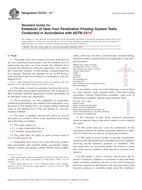
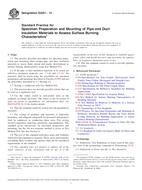 ASTM E2231-14
ASTM E2231-14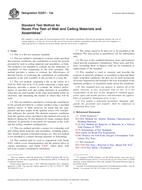 ASTM E2257-13a
ASTM E2257-13a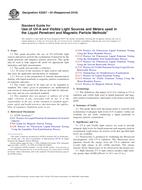 ASTM E2297-04(2010)..
ASTM E2297-04(2010)..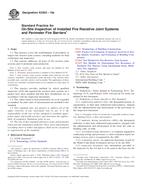 ASTM E2393-10a
ASTM E2393-10a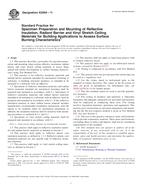 ASTM E2599-11
ASTM E2599-11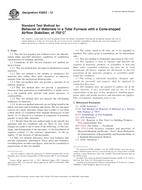 ASTM E2652-12
ASTM E2652-12
 Cookies
Cookies
